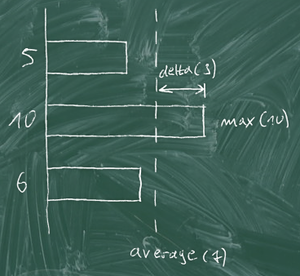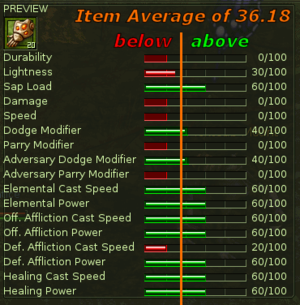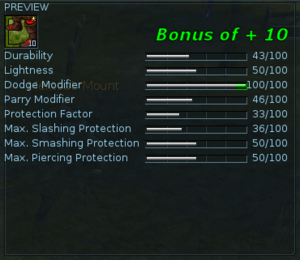| |
Alerte au spoiler ! L'article suivant contient un guide étape par étape pour recréer et comprendre les mécanismes de fabrication du jeu. Bien que toutes ces informations soient accessibles au public via le code source du jeu, elles restent un mystère pour beaucoup. Si vous voulez garder ce mystère, ne lisez pas ce qui suit !
Sommaire
Définitions
Nous devons nous mettre d'accord sur les trois points suivants pour parler de l'artisanat. Pour citer mon personnage préféré d'un autre jeu : "Les chiffres, les chiffres, les maths, les maths, les maths !"
- Moyenne
- Additionner les nombres donnés et diviser la somme par leur nombre.
- Maximum
- Le plus grand nombre d'un ensemble est appelé maximum.
- Delta
- La différence entre deux nombres est appelée une valeur delta (Elle peut également être négative, selon la perspective).
Théorie
Il y a eu quelques mythes sur la mécanique de l'artisanat dans la communauté. Commençons par quelques faits :
- L'artisanat est le même pour tous les objets, plans et recettes. Un amplificateur magique est traité de la même manière qu'une hache à deux mains.
- Ni les matériaux, ni les parties spécifiques des objets n'influencent la mécanique de l'artisanat ; ils sont tous égaux. Seul le résultat de la combinaison de tous les matériaux a un impact.
- Les matières premières n'ont pas de statistiques cachées.
- L'origine d'une matière première n'a pas d'importance. Un morceau d'ambre de beng de forêt excellent est égal à son pri2. La réalité (dans le jeu) est la contrepartie des racines.
L'artisanat en général se déroule en deux phases, ce sont:
- calculer les valeurs des statistiques des articles individuels en fonction des matières premières utilisées ;
- appliquer une majoration ou un bonus à ces valeurs, le cas échéant.
Nous allons utiliser une recette d'amplificateur magique comme exemple et examiner une recette d'armure légère dans la deuxième phase également. Les recettes sont les suivantes :
- Amplificateur magique de qualité de base
- 5x écorce de Mitexi de base,
- 5x Fibre Shu de base,
- 10x Choix Zun Amber.
- Bottes légères de qualité de base
- 2x Choice Shu Fiber,
- 2x Résine lunaire de choix,
- 1x Choice Gulatch Oil,
- 1x Choix Visc Sap.
Phase 1, calculer les valeurs pour les stats individuelles
Pour calculer les valeurs de chaque stat de l'article résultant, chaque article contribuant à cette stat doit être pris en compte. La première stat est la durabilité et il apparaît dans les trois matériaux avec des valeurs différentes.
<bloc citation>5x écorce de base mitexi pour le manche, avec une durabilité de 0
5x la fibre dzao de base pour la prise en main, avec une durabilité de 20
10x le choix de l'ambre zun pour la concentration magique, avec une durabilité de 30</bloc citation>
La quantité de matériaux utilisés et leur valeur réelle pour la durabilité doivent être prises en compte pour le calcul. Pour notre amplificateur magique, la valeur moyenne de la durabilité est :
- (5x0 + 5x20 + 10x30) divisé par (5+5+10) = 400 / 20 = 20
Les autres statistiques sont calculées de la même manière. Faites attention à ne pas inclure des matériaux qui ne contribuent pas à une statistique dans l'article résultant ! Les dommages, par exemple, ne sont influencés que par le matériau de l'arbre <refvérifier la trad de shaft</ref>. Ni la prise, ni la mise au point magique ne contribuent aux dommages de quelque manière que ce soit. La stat résultante est calculée comme suit :
- (5x 0) divisé par 5 = 0
Si nous répétons ceci pour toutes les statistiques, les statistiques résultantes pour notre amplificateur magique ressemblent à ceci:
20 Durabilité
35 Légèreté
50 Puissance de guérison
50 Sap Load
0 Dommage
20 Vitesse
40 Modif esquive
20 Modif Parade
40 Modificateur d'esquive de l'adversaire
10 Modificateur de parade de l'adversaire
50 Vitesse élémentaire
50 Puissance élémentaire
50 Vitesse du sort Affliction offensives
50 Puissance Affections offensives
30 Vitesse du sort Affliction défensive
50 Puissance de l'affection défensive
50 Vitesse de guérison
La phase 1 s'achève ici. Les statistiques sont très différentes des valeurs affichées dans la fenêtre de prévisualisation des éléments, nous aborderons cette question dans la phase 2.
Phase 2, appliquer une extension ou un bonus
Phase 2-1 (une extension à toutes les statistiques)
Phase 2-2 (pas de changements)
Phase 2-3 (une prime unique pour la plus haute stat)
La réalité (en jeu)
Big spoiler alert! The following article contains a step by step guide to recreate and understand the crafting mechanics of the game. While all of this information is available to the public via the game’s source code, it is still a mystery to many. If you want to keep this mystery, don't read on!
This article explains how to get from individual raw materials to the stats shown in the craft preview window. A big thanks to all who helped in the creation of this article and to robplus for editing.
Contents
0. Definitions
We need to agree on the following three things to talk about crafting. To quote my favorite character from another game: "Numbers, Numbers, Math, Math, Math!"
- Average
- Sum up the given numbers and divide the sum by their count.
- Maximum
- The largest number in a set is called maximum.
- Delta
- The difference between two numbers is called a delta value. (It can also be negative, depending on the perspective.)
1. Theory
There have been some myths about the crafting mechanic floating around the community. Let us begin with some facts:
- Crafting is the same for all items, plans and recipes. A magic amplifier is processed in the same way as a long axe.
- Neither individual materials nor specific item parts influences the crafting mechanic; they are all equal. Only the result of all combined materials has an impact.
- Raw materials don't have any hidden stats.
- The origin of a raw material does not matter. A piece of excellent forest beng amber is equal to its prime roots counterpart.
Crafting in general happens in two phases, these are:
- calculate the values for the individual item stats based on the used raw materials;
- apply a stretch or a bonus to these values, if applicable.
We are going to use a magic amplifier recipe as an example and have a look at a light armor recipe in the second phase as well. The recipes are as follows:
- Basic Quality Magic Amplifier
- 5x Basic Mitexi Bark,
- 5x Basic Shu Fiber,
- 10x Choice Zun Amber.
- Basic Quality Light Boots
- 2x Choice Shu Fiber,
- 2x Choice Moon Resin,
- 1x Choice Gulatch Oil,
- 1x Choice Visc Sap.
Phase 1, calculate the values for the individual item stats
To calculate the values for each stat of the resulting item, every single material contributing to this stat has to be taken into account. The first stat is durability and it appears in all 3 materials with different values.
5x basic mitexi bark for shaft, with a durability of 05x basic dzao fiber for grip, with a durability of 20
10x choice zun amber for magic focus, with a durability of 30
The amount of materials used and their actual value for durability has to be taken into account for the calculation. For our magic amplifier the average durability value is:
- (5x0 + 5x20 + 10x30) divided by (5+5+10) = 400 / 20 = 20
The other stats are calculated in the same way. Take care not to include materials which don't contribute to a stat in the resulting item! Damage, for example, is only influenced by the shaft material. Neither grip nor magic focus contribute to damage in any way. The resulting stat is calculated like this:
- (5x 0) divided by 5 = 0
If we repeat this for all stats, the resulting stats for our magic amplifier look like this:
20 Durability
35 Lightness
50 Heal Power
50 Sap Load
0 Damage
20 Speed
40 Dodge Modifier
20 Parry Modifier
40 Adversary Dodge Modifier
10 Adversary Parry Modifier
50 Elemental Cast Speed
50 Elemental Power
50 Offensive Affliction Cast Speed
50 Offensive Affliction Powe
30 Defensive Affliction Cast Speed
50 Defensive Affliction Power
50 Heal Cast Speed
Phase 1 ends here. The stats look quite different from the values shown in the item preview window, we will address this issue in phase 2.
Phase 2, apply a stretch or a bonus
There are 2 different mechanics which can be applied to the stats of an item. To decide which one is used, we need the average and the maximum of the item stats. The average for the magic amplifier is:(20 + 35 + 50 + 0 + 20 + 40 + 20 + 40 + 10 + 50 + 50 + 50 + 50 + 30 + 50 + 50 + 50) divided by 17 = 36.18The maximum value of 50 occurs several times.The game looks at how much the best stat stands out from the rest. In mathematic terms, we need the delta between the maximum and the average. With this delta, the course of action is chosen as follows:* delta is below 30 All stats are stretched by a certain amount. Good stats get better, bad stats get worse. (Phase 2-1)
- delta is 30 or above but still below 35 No changes are applied. (Phase 2-2)
- delta is 35 or above The highest stat will receive a bonus of +10. If there are multiple stats eligible for this bonus, only the first one is considered. (Phase 2-3)
Our magic amplifier has a delta of 50 - 36.18 = 13.82. The first mechanic will be applied.
Phase 2-1 (a stretch to all stats)
- The Stretch
- All stats are stretched in relation to the average of the item. Stats below the average get worse, stats above it get better. The only variable left is the amount by which these values are stretched. It is the same for all stats and is calculated as the ratio of 30 and the delta between the maximum and the average. Let's call it the Stretch Factor and calculate it for our magic amplifier:
- Stretch Factor = 30 divided by (50 - 36.18) = 2.17
So we have a Stretch Factor of 2.17. However there are limitations on how high or low this value can get. It has a lower limit of 1 and an upper limit of 2. In this case the upper limit is exceeded, so the Stretch factor is set to exactly 2.
Now it is time to apply this stretch to the actual values. The values aren't multiplied directly with this factor, but instead their delta with the item average is. After the stretch, the average is added back to the delta, to get the actual value for the stat.
- Example
- The first stat is durability with a value of 20. The item average is 36.18. The delta is (20 - 36.18) = -16.18. Now it is multiplied with the Stretch Factor of 2: (-16.18) * 2 = -32.36. The average is then added back to it, to get the actual value: (-32.36) + 36.18 = 3.82. This calculation can also be written in a single line:
- Stretched Stat = (Original Stat - Average) * Stretch Factor + Average
For durability it looks like this:
- durability = (20 - 36.18) * 2.0 + 36.18 = 3.82
For damage we encounter a problem:
- damage = (0 - 36.18) * 2.0 + 36.18 = -36.18
The value is negative. The craft preview does not have negative numbers. In fact it only allows values between 0 and 100. This is similar to the values on raw materials and material grades. We will deal with these values in another step, but for now the stretched stats are as follows:
3.82 Durability
33.82 Lightness
63.82 Sap Load
-36.18 Damage
3.82 Speed
43.82 Dodge Modifier
3.82 Parry Modifier
43.82 Adversary Dodge Modifier
-16.18 Adversary Parry Modifier
63.82 Elemental Cast Speed
63.82 Elemental Power63.82 Offensive Affliction Cast Speed
63.82 Offensive Affliction Power
23.82 Defensive Affliction Cast Speed
63.82 Defensive Affliction Power
63.82 Heal Cast Speed
63.82 Heal Power
- Cut Off Values
- The game cuts off values below 0 and above 100. In both cases the resulting item is deformed - it loses or gains stats depending on the amount of negative and positive stats cut off. To correct this, the missing amount needs to be reintroduced to the item again. It has to be distributed among the remaining stats. In case one of the adjusted stats ends up cut off again, the process simply repeats.If we look at our magic amplifier, there are two stats getting cut off. Damage with -36.18 and Adversary Parry Modifier with -16.18. They are both below zero and will be changed to zero. The total amount cut off has a value of:
- (-36.18) + (-16.18) = -52.36
This amount has to be distributed equally among the 15 non cut off values, which is a change of (-52.36) divided by 15 = -3.49 per value. After applying these corrections, the magic amplifier stats for the preview window are as follows:
0.33 Durability
30.33 Lightness
60.33 Sap Load
0 Damage
0.33 Speed
40.33 Dodge Modifier
0.33 Parry Modifier
40.33 Adversary Dodge Modifier
0 Adversary Parry Modifier
60.33 Elemental Cast Speed
60.33 Elemental Power
60.33 Offensive Affliction Cast Speed
60.33 Offensive Affliction Power
20.33 Defensive Affliction Cast Speed
60.33 Defensive Affliction Power
60.33 Heal Cast Speed
60.33 Heal Power
- Final Display
- The item preview window only displays the integer part of these stats and removes all the decimals (it doesn't round the numbers!). 0.33 becomes 0, 40.33 becomes 40, and so on. And that's it! Your first item crafted with pencil and paper. Congratulations!
- Side Note
- The item kept its original average value of 36.18 roughly the same. It didn't get better or worse. The new average is:
- (0.33 + 30.33 + 60.33 + 0 + 0.33 + 40.33 + 0.33 + 40.33 + 0 + 60.33 + 60.33 + 60.33 + 60.33 + 20.33 + 60.33 + 60.33 + 60.33) divided by 17 = 36.17
Phase 2-2 (no changes)
The values stay the same.
Phase 2-3 (single bonus to the highest stat)
- Back to Phase 1
- This time we use Basic Quality Light Boots as example. The first step is again to calculate the individual item stats according to phase 1. They are:
43.33 Durability
50 Lightness
50 Max Piercing Protection
90 Dodge Modifier
46.67 Parry Modifier
33.33 Protection Factor
36.67 Max Slashing Protection
50 Max Smashing Protection
We then determine which course of action the game will take. The item average and maximum stats are used again to calculate the delta value. The average is
- (43.33 + 50 + 90 + 46.67 + 33.33 + 36.67 +50 +50) divided by 8 = 50,
which is not surprising, as only materials of the Choice grade were used. The maximum is 90, which leads to a delta of (90 - 50) = 40.
- The Bonus
- In this case no stretch is applied to the stats; instead, a one-time bonus of +10 is given to the first occurrence of the highest stat. For our light boots, Dodge Modifier is the highest stat with a value of 90. It gets a bonus of +10 and becomes 100 in the item preview. If this bonus leads to cut off stats (e.g., 96 + 10 = 106), the cut off amount is neglected and no correction is applied to the other stats.
- Side Note
- This time, the item got better. The average has changed from 50 to 51.25!
2. Reality (Ingame)
The theory has proven itself to be valid countless times and has been confirmed by an examination of the game's recently available source code. However, there are still some mysteries for the adventurous homin to solve!
One of them is the following recipe:
The delta is above 35 so only a one-time bonus of +10 is applied, yet Poison Protection is at 69 instead of 70 and Forest Resistance at 59 instead of 60. Forest Resistance is only influenced by the Caprice Seed in Jewel Setting with a value of 60. For the individual item stat we have (3x 60) divided by 3 = 60. It does not get a bonus being the second stat with the maximum of 60, so those values in the preview window must be the ones from the first Phase...
- Edit
- It has been confirmed to be a rounding error by the old client, new one is just fine!
Another observation is an exception to the rule for material grades. It seems a durability of 0 is not allowed. Any other stat can be 0, but durability can't. It is set to 1 in the game client for all cases it would be 0. This may or may not be the same for the game server. Yet another mystery to solve...
To sum it up, the game still surprises even the most veteran crafter and has its own little quirks which keep crafting challenging and fun!
Thank you for reading!
| Arcueid's Crafting Guides Crafting and Colors ⚪ Crafting and Materials ⚪ Crafting and Math |




